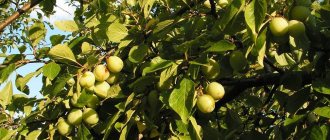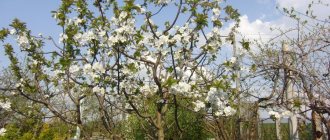Rose Claire Austin was bred by David Austin in 2007 and named after the breeder's daughter. When breeding Claire Austin, David used a hybrid tea flower, crossing it with a French variety of roses. As a result, the new look turned out much more graceful and became one of the best varieties of Austin roses.
David Austin - breeder
Description of rose scrub Claire Austin
The Claire Austin rose variety can be of two types - climbing and bush. Description of the shade of Claire Austin rose petals (pictured) - white with a slight lemon admixture at the beginning of flowering, beige-pinkish at the end. When a flower first emerges from a bud, it looks like an ordinary rose, but as it opens, it becomes double and voluminous, reaching a diameter of 10 cm, gathering into inflorescences that contain 2-3 buds. The plant, like all “ostins”, has a strong, pleasant aroma. The main note of the scent is tea rose, but vanilla is also clearly audible. One bush of this rose variety can produce from 50 to 120 buds. With proper care, flowering occurs twice per season - in June and again at the end of August, until the end of September.
Important! Claire Austin is most popular in the Krasnodar Territory, some regions of Crimea and the North Caucasus.
Description of the Claire Austin rose bush: it is abundantly strewn with emerald leaves. They are a rich, bright green color, juicy, with a glossy sheen. The shoots of the plant are straight, but can bend down, forming a wide bush, and sometimes become curly.
Rose bushes are very tall - from 1.5 m, sometimes they grow up to 2 m in width. It is worth noting that in central Russia the bush variety takes root, and for the southern regions the climbing variety is quite suitable.
Possible disadvantages of the plant include:
- The rose variety is prone to climbing, so if not properly cared for or pruned incorrectly, it may have an unkempt appearance;
- does not like excessive moisture;
- Flower petals fly away too quickly.
However, the obvious advantages of Claire Austin - beauty and aroma - cover all the shortcomings of this variety.
Frost resistance, drought resistance
The rose has a very good frost resistance. Claire is also resistant to powdery mildew and black spot, which plague the plant when exposed to excessive humidity. It has been noticed that the variety grows and develops differently in different climatic conditions of our country. However, in any case, the rose requires shelter for the winter.
Attention! Of all the flowers in David Austin's collections, the Claire Austin rose (pictured) is his star attraction. Its white flowers are collected in inflorescences and located on straight shoots.
The nobility of the bud amazes the eye.
The English rose tolerates the heat quite patiently. Feels good in the southern regions. But this does not mean that it will not require regular watering.
Read more How to prepare a bush rose for winter
Advantages and disadvantages of the variety
Flower growers who grow this variety on their plots note its main advantages:
- high resistance to frost;
- if frozen shoots are severely pruned in the spring, then during the summer season they quickly grow back to their original size;
- there are practically no thorns on the shoots;
- The flowers are well suited for cutting; they can stand in vases for up to 12-14 days.
This beautiful perennial has practically no disadvantages. At least among the reviews from gardeners, no obvious disadvantages of the variety were noted.
Claire Austin is a rose with amazing characteristics that are difficult to find among other varieties. Considering that this variety can be successfully grown in the Moscow region and other regions with a similar climate, Russian flower lovers should pay attention to it.
Rose Morden Blush
0 0 votes
Article rating
Application in landscape design
Rose Claire Austin can be grown as a scrub. It makes unusually beautiful hedges, borders, and lawns. It looks especially gentle against the background of other bright colors. With its help, gardeners make chic arches, columns, sheer walls and fences.
Such experiments are possible due to the special characteristics of the flower, because the rose is quite unpretentious in care, resistant to diseases and insect pests. In addition, Claire blooms profusely, which is why it is so readily used in landscape design. Rose looks very beautiful even alone. Of course, shrubs look most advantageous during the flowering period. Rose Claire Austin is appropriate in any style - classic French, country, English landscape and even modern.
Important! All new varieties of roses from the English breeder David Austin grow in the Renaissance garden.
Peony roses photos, list of varieties
The most popular bush varieties of peony roses include the varieties “Miranda”, “Claire Austin”, “Tranquility” and others.
The Miranda variety was released only in 2005. The flowers of the plant have a faint, pleasant, sweetish odor. The plant grows as a bush 1 to 1.5 meters high. The flowers are solitary with white petals on the outside and pink on the inside.
Peony roses photos, list of varieties
The "Claire Austin" variety is distinguished by its pronounced aroma. An adult plant reaches 1.5 meters in height and approximately 1 meter in width. The flowers of this variety are white or cream-colored, 10 cm in diameter, and are collected in inflorescences of up to 3 pieces on the bush.
The Graham Thomas variety has become known since 1983. The height of the bush depends on the climatic conditions of plant growth, and varies from 1 to 3 meters. The flowers are yellow, large, up to 12 cm in diameter, collected in inflorescences of up to 5 pieces. There is a pleasant, slightly pronounced aroma from the bush.
The Tranquility variety, which has become famous since 2012. Therefore, there are still few reviews and advice about it from gardeners and florists. The bush grows small, up to 1.5 meters high, with extremely rare thorns. The flowers of the Tranquility variety are yellowish in color.
The variety "Golden Celebration" has yellow-golden flowers that grow up to 16 cm in diameter, with a delicate, strongly pronounced aroma.
Variety "Munstead Wood". The bush of this variety grows small, up to 1 meter in height and up to half a meter in width. Medium-sized flowers are collected in inflorescences of 5 pieces. A special feature of this variety is the velvety nature of the petals, which change color from light pink to black-red.
Climbing peony varieties include the “Constancespray” variety. This variety was bred in 1961. The height of plants of this variety can reach up to six meters and the width up to three meters. The leaves of plants of this variety are large and hard, and the pagons have small but frequent thorns. The flowers are large, up to 14 cm in diameter, collected in inflorescences of up to 6 pieces with a strong aroma.
Reproduction methods
In order to preserve all the characteristics of the variety, this rose should be propagated vegetatively. At home, the simplest, most convenient and effective way to propagate English roses is by cuttings.
Cuttings are prepared from stems by dividing it into several parts. As a rule, the middle or upper part of the stem is taken for this. Next, you need to remove the lower leaves, making sure to leave at least 3 buds and the upper leaves.
The upper cut is made straight, and the lower one needs to be cut diagonally. There should be no uneven, torn edges. If the cuttings have taken root, the buds begin to turn green; if not, they remain black. The length of the cutting is from 20 to 30 cm.
Methods for rooting cuttings
It is important to know how to properly root cuttings.
There are several ways to root cuttings, but none gives a 100% guarantee that the procedure will be successful. The most common rooting options:
- Summer cuttings of roses. The stem is cut in the morning or late in the evening. Incisions are made with a sterile instrument, and a solution of root or other growth stimulant is used. Cuttings can be planted on the site after fertilizing the soil and covering it with a glass jar.
- "Burrito." The stem is divided into cuttings, the lower part is rubbed with root or epin solution, wrapped in wet newspaper and left for several weeks in a dark, cool place. After the specified period of time, the cuttings should take root. However, many question this method of rooting cuttings.
- Rooting in the cold season. The method is used if there is a need for rooting in winter to preserve the rose. In this case, the cutting is planted in open ground after all the preparatory procedures, and covered on top so that it does not freeze. In spring, the plant should be transplanted to its permanent habitat.
Advice! Instead of a solution of Epin or Kornevin, you can use the folk method of preparing a stimulant. To do this, take 0.5 tsp. honey and 1 glass of water, mix and add crushed juicy leaves.
Rose blossom
The plant experiences periods of activity and dormancy. During flowering, roses need timely watering and fertilizing with an infusion of plant origin (for example, nettle infusion) mixed with rotted manure. After flowering, the bush begins to prepare for winter, at which point complex potassium-phosphorus fertilizers are applied. The rose is at rest.
It also happens that a purchased seedling grows, but does not bloom. This is normal if the rose is planted for the first year. On the second or third day, the plant gains strength and begins to bloom. However, if conditions are not suitable, flowering may not occur until later.
Interesting! Usually you need to change either the frequency of watering or transplant to a more suitable place. Sometimes the cause of delayed flowering is a lack of phosphorus or excess nitrogen.
Planting and caring for shrub rose Claire Austin
Before landing Claire Austin, you need to choose the right place. The rose is a bush plant, therefore, it will take up a lot of space in the rose garden. Like all English roses, the rose tolerates partial shade well, but in order for it to show all its beauty during flowering, it will need sun. The plant should not be located in lowlands, near groundwater.
Read more When and how to open roses in spring in the Moscow region
Preparing for winter
The soil should be as light as possible, enriched with minerals. It is best to plant in the fall. The first year the shrub will require increased attention and care. At this time, it is important not to miss possible diseases and pests that can destroy the flower. Thus, after a place has been allocated for the plant, a hole has been prepared for the “suspension”, fertilizer should be poured onto the bottom and the rose can be planted. Then lightly crush the soil and water generously.
Aftercare
Despite the fact that Claire is an unpretentious plant, she will require special care at first. It should consist of proper watering of the plant, proper feeding, timely pruning and preparing the plant for the winter. In addition, you need to carefully monitor how the rose takes root in a new place in order to reduce the risk of death of the bush.
Trimming
Shrub pruning is the most important procedure for Claire Austin roses. You need to not miss the moment and do it after the buds have swelled and the shoots have managed to grow 3-5 cm. The shrub is thinned out well, leaving only a few strong, healthy shoots. All dry, rotten, broken, old ones must be removed, otherwise they will not allow the plant to develop to its full potential.
Attention! Sections are made a few centimeters above the kidneys and at a slight angle. During the procedure, the instrument must be sharp and sterile.
It is advisable to cut the Claire Austin variety by half, then it will bloom abundantly in early summer. After wilting, the flowers will need to be removed so that the shrub produces a second wave of flowering in August.
Preparing for winter and sheltering for the winter
One of David Austin's rose gardens
Claire Austin's rose will need shelter from the frost. There is no need to rush into this event - light frosts are not scary for her. On the contrary, they help the plant prepare for winter. It is necessary to cover the bush with the onset of stable frosts. Before the procedure, the rose is pruned, hilled up near the roots, you can add compost, humus, but in no case peat or sawdust - they are very moisture-intensive and the rose will not tolerate sudden changes in temperature. Experienced flower growers use spruce spruce branches in their rose gardens as a covering material, laying it along and on the bushes. After this, a frame is installed, 20-30 cm higher than the bush itself, and a layer of insulating material is pulled on top, leaving small holes so that the rose can breathe. They open the flower in early spring, gradually accustoming it to the air.
Read more Shelter for climbing roses for the winter in the Moscow region, the Urals, and Siberia
Features of cultivation
Claire Austin's roses are classified as Shrub roses, and this is associated with planting and care features. The rose scrub is distinguished by enlarged buds, spreading bushes and abundant flowering.
The first year after planting, a rose of this variety especially needs attention; if care rules are not followed, the plant may wither and die.
Selection of seedlings
Seedlings are purchased by choosing from the following options:
- with an open root system;
- planted in a container;
- packaged with soil.
Bare-root rose seedlings are usually planted in the fall. The rest are suitable for spring planting. Each seedling must meet several requirements in appearance:
- be free from damage, dents, stains;
- with a developed root;
- no wet parts;
- with the root tightly attached to the main stem.
Advice! The roots should be clearly visible at the bottom of the container, and soil crumbs in the bag with the substrate should be poured out when turned over.
Site preparation
Before planting, the soil is fertilized with compost or another type of organic matter, dug several times, saturating it with air.
The planting hole should be no deeper than 65 cm, and the diameter of the hole should be from 60 to 70 cm. Drainage (broken brick, crushed stone, expanded clay, verticulite) is laid at the bottom of the hole. The drainage layer is made from 4 to 6 cm. The root system of the rose bush needs excess moisture to accumulate not in the soil around it, but on the drainage layer.
Landing dates
Planting is planned for mid-April - mid-May. The exact timing depends on the characteristics of the climate zone.
If necessary, roses are planted in the fall, but then care is taken to ensure that the plant has time to adapt to new conditions before the first frost.
Landing technology
Before planting, the roots of the seedling are soaked in a root growth stimulator.
These are special complexes that can be purchased at nurseries (for example, “Kornevin”, “Heteroxin”). Soaking lasts 24 hours. Then they start planting:
- A layer of soil is poured onto the drainage layer of the planting hole.
- Then the seedling is installed in the center of the hole.
- Cover the edges with soil until completely filled.
- The earth around the bush is compacted.
- The hole is watered generously with warm water.
Many gardeners recommend mulching the soil after absorbing moisture, and the mulch layer should not exceed 6 - 7 cm. An important condition for the planting process is to deepen the grafting by 10 cm.
Diseases and pests
The main diseases to which Claire Austin is exposed include:
- powdery mildew;
- gray rot;
- rust;
- black spot.
To treat Claire Austin in the spring, preparations containing organic matter and nitrogen are used. If you do not treat and prevent diseases in time, the plant turns yellow and soon dries out.
Pests that plague roses include spider mites, sawflies, aphids and leaf rollers.
Rose John Davis - what kind of variety is this, history of creation
Rose John Davis is a hybrid crop.
Roses are characterized by deep pink flowers.
It was bred from wild rose hips and rose Rugosa.
Brief description, characteristics
The description of the rose says that it is a shrub that is suitable for vertical gardening. With the help of park plants you can decorate fences, balconies, and buildings.
The bushes of this variety are powerful and spreading. They reach 2 m in height and 2.5 in width. The plant has long and flexible shoots covered with a minimum of thorns. As the bushes develop, the branches stick to the surface of the ground. The culture is characterized by small leaves of a rich green color.
The flowers form clusters of 10-15 pieces. Their diameter is 7-8 cm. The buds have a semi-double structure and a rich pink color. The flowers are characterized by a yellow-beige base. After some time, they fade in the sun and acquire an ashen color.
Important! Abundant flowering is observed in early summer, after which it becomes more moderate. The bushes bloom until the end of autumn
This variety is characterized by excellent winter hardiness. The culture can withstand frosts down to -29 degrees without shelter. The plant is characterized by resistance to disease. In unfavorable conditions it may suffer from powdery mildew. There is also a risk of developing black spotting. The bushes require virtually no pruning.
Advantages and disadvantages of the variety
The John Davis rose has the following advantages:
- frost resistance;
- disease resistance;
- early onset of flowering;
- abundant and lush flowering;
- resistance to sunlight;
- Possibility of use for garden decoration.
At the same time, culture also has certain disadvantages:
- poor development in the shade;
- need for fertile soil;
- the need for frequent and abundant watering.
Use in landscape design
Since the plant reaches a height of 2 m, it is recommended to plant it in a composition of 3-4 bushes. It is better to use roses of different colors. Such compositions go well with coniferous plants.
Roses are often used to decorate a garden plot.
You can also use lupine, astilbe, and armeria as additions. Sage or juniper will look no less successful.
Further care
After planting flowers, you need to provide them with comprehensive care for active growth and abundant flowering. Plants need regular watering, shaping, fertilization and protection during the cold season.
Watering rules and humidity
The bushes are moistened as the top layer of soil dries. Under normal weather conditions, it is enough to water the plants once every 5-7 days. Watering is carried out in the evening, using rain or settled warm water. If the Claire Austin rose is grown as a bush, 5 liters of water will be enough for each planting. When grown in a climbing manner, the liquid consumption will increase to 15 liters.
Roses need to be watered throughout the summer. In the case of a rainy summer, it is advisable to stop moistening towards the end of July, since waterlogging of bushes often leads to the development of diseases.
Pruning and shaping the bush
Bushes are pruned in the first year after being transferred to the ground. Towards mid-spring, when the buds swell and the shoots grow up to 5 cm, thinning is required. 3-4 of the most powerful shoots are left on the bushes, removing all old, small and broken ones. Otherwise, they will absorb forces from the plants, which will lead to stunted growth and flowering. Additionally, it is recommended to cut off woody shoots every 5 years for the active development of fresh growth.
Fertilizing
Claire Austin roses need to be fed at least three times during the warm period. Plants need the following fertilizers:
- nitrogen-containing substances before flowering;
- organic and complex microelements before buds open;
- phosphorus-potassium fertilizers on the eve of the first frost.
Description of the best varieties of grandiflora roses, cultivation technologyRead
As a rule, fertilizing begins in the first summer after planting roses. But if humus or organic matter was added to the hole when planting, then fertilizers are used from the second year of growth.
Features of wintering a flower
In cold climates, the Claire Austin rose freezes in winter, so it is important to properly prepare the plant for the cold. Preparations begin in early October by hilling the bushes
Then the plantings are tilted closer to the ground by laying wooden boards or foam plastic under them. After waiting for the first frost, all available buds and leaves are cut off from the shoots to reduce the risk of fungal diseases. The prepared shoots are covered with spruce branches and dense non-woven material.











